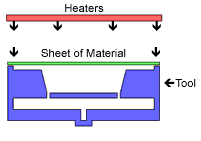Injection Moulding vs Vacuum Forming
![]() Injection Moulding and Vacuum Forming are two very popular processes to make plastic parts. This article explains the capabilities of both processes and gives a basic guideline of the kinds of products each process is most suitable for. First, a quick summary of how the processes work:
Injection Moulding and Vacuum Forming are two very popular processes to make plastic parts. This article explains the capabilities of both processes and gives a basic guideline of the kinds of products each process is most suitable for. First, a quick summary of how the processes work:
What is injection moulding?
Injection moulding is a way of making plastic parts by melting the plastic material and injecting this into an injection mould tool. For more detail, have a look at our schematic overview of the injection moulding process, or watch our screwthread injection moulding video to see it in action.
What is vacuum forming?
Vacuum Forming is a way of forming plastic parts by stretching a heated sheet of plastic over a vacuum forming tool. You can have a look at our vacuum forming process page, or watch our vacuum forming video for an in-depth explanation.
Vacuum Forming vs Injection Moulding - What Can They Achieve ?
This table sums up the other differences between the two processes:
| Injection Moulding | Vacuum Forming | |
|---|---|---|
 |
 |
|
| Process capabilities | Injection moulding can make incredibly detailed parts, with micro-sized parts still able to have ribs, bosses, metal inserts, more than one moulding material, side cores, screwthread, holes….. Because the plastic is injected inside the mould, the product can have just about any shape, as shown by the injection moulding above.
The results hang on the correct design & manufacture of the injection mould tool that forms the part, on correct choice of material & correct use of the injection moulding machine. |
Vacuum Forming is not nearly as versatile as injection moulding. Because the plastic sheet is stretched over or into a mould, the shaping is done in only one direction, limiting the shape of the part. However, vacuum forming is capable of achieving much thinner walls on products. Parts are always hollow, as shown by the vacuum forming above. The holes have been cut afterwards.
With good tool design the vacuum forming can achieve sophisticated products and a range of special features. |
| Precision & tolerances | Injection moulding can achieve incredibly small tolerances, achieving identical products time and again. | Vacuum Forming can achieve reasonable tolerances, but as the material is stretched over or into a tool, it is less controlled than injection moulding. |
| Materials | The range of materials is huge ! There's a huge range of standard materials, but also things like antistatic plastic, thermoplastic rubber, chemical resistant plastics, infrared, biocompostable...and with colour compounding or masterbatch colouring you have an endless choice of colours as well. | More limited range of materials, but sheets are readily available in ABS, Fire Retardent ABS, HDPE, HIPS, Conductive HDPE, Conductive HIPS, PP, PVC, Clear HIPS, Ultra Violet Stable HIPS & PETG. A range of colours and special effect sheets are also available. |
| Finishing & Waste | Each mould tool has 'runners' - channels in the tool through which the molten plastic reaches the core & cavity that shapes the product.
If the mould tool has cold runners, they will set hard during each moulding cycle. They need to be removed from each moulding and can be reground and re-used.
In hot runner mould tools, the plastic in the runners stays hot and gets used in the next moulding, so there's no waste during production. |
The actual product always needs cutting out of the plastic sheet – this can be done by for example roller cutting, handcutting or CNC machining.
Depending on the sheet & part size, this can be a fairly wasteful process. However, leftover sheet parts can be reground and used in other processes. |
Here at Toolcraft, we offer both vacuum forming and injection moulding and with years of experience of both, we are very well placed to advice you on which process is right for you, taking into consideration all of these factors.


